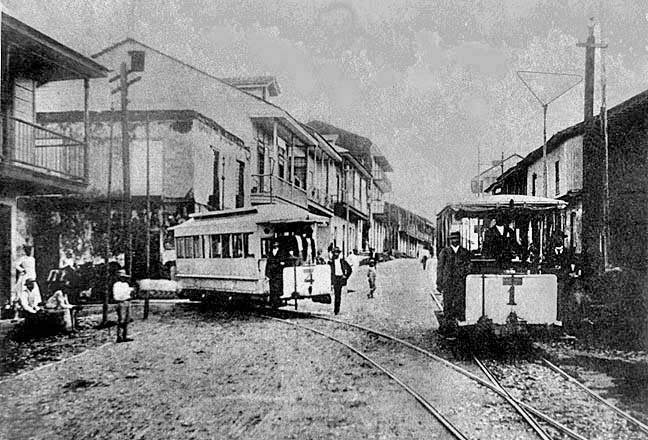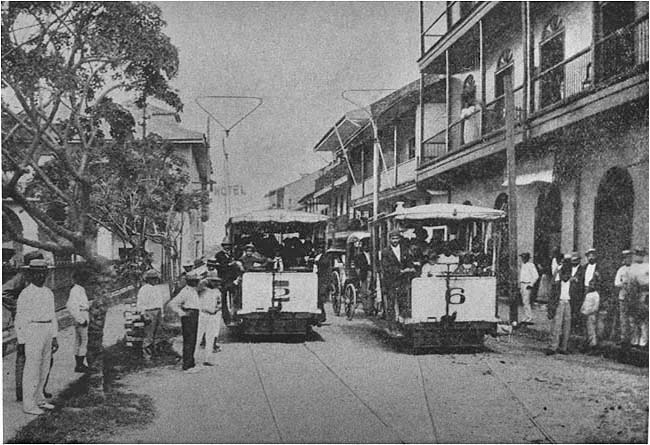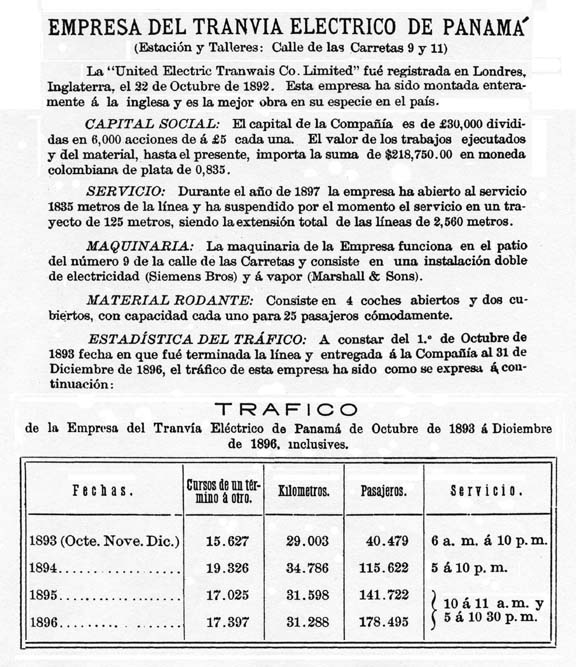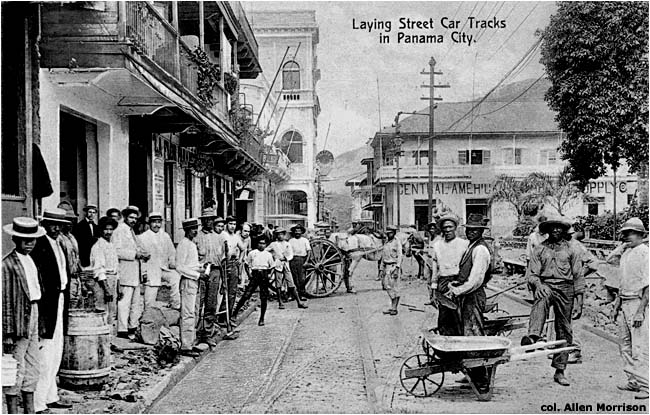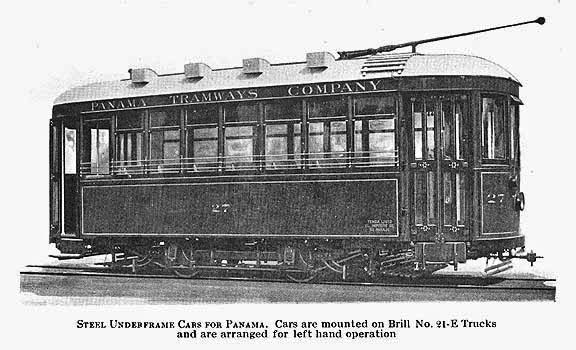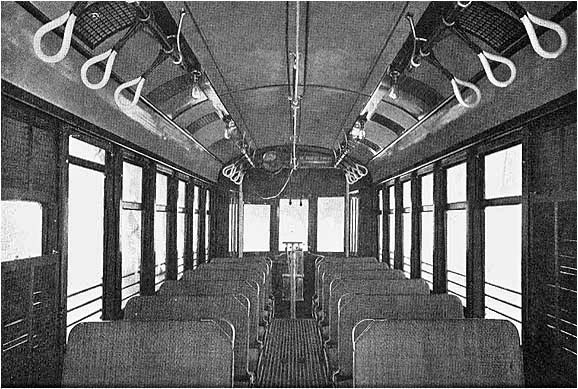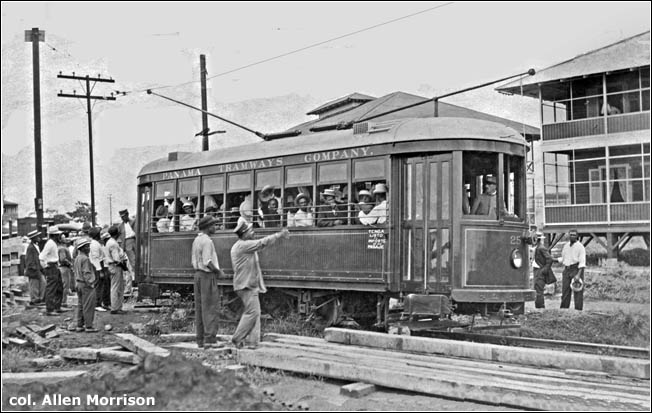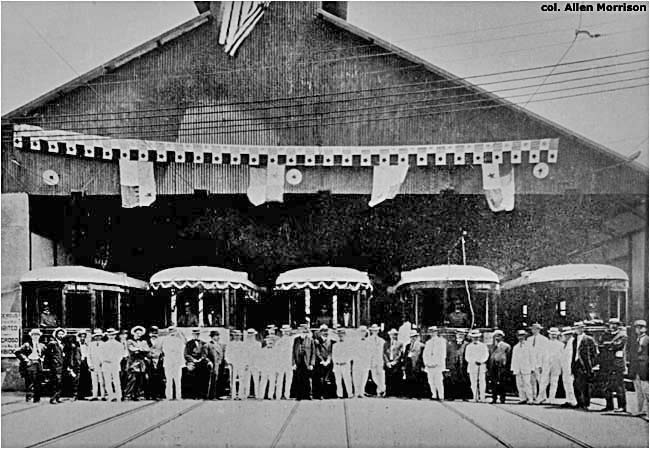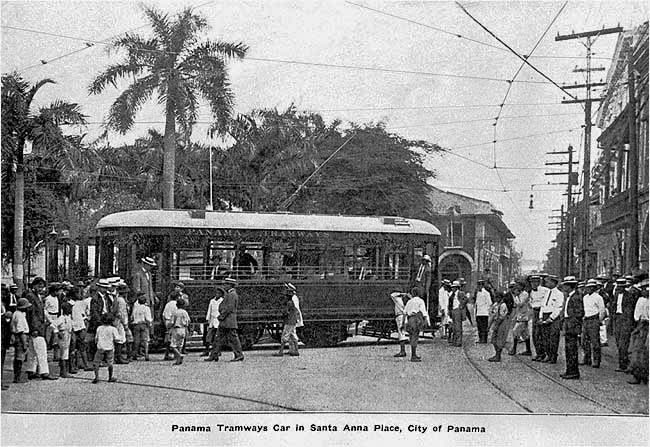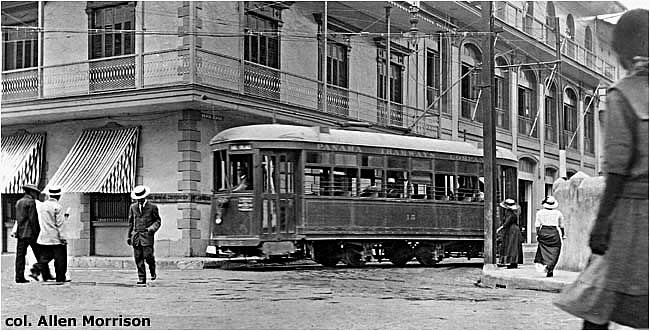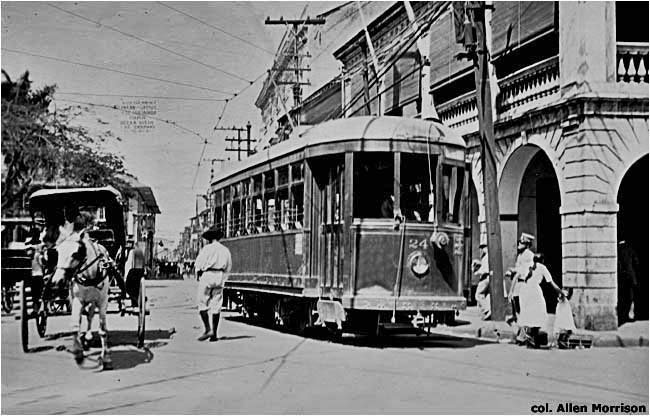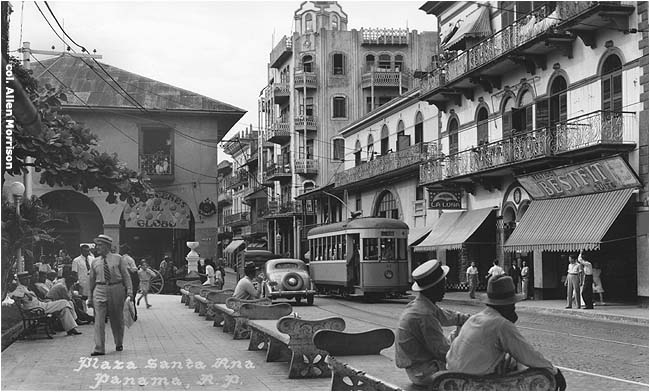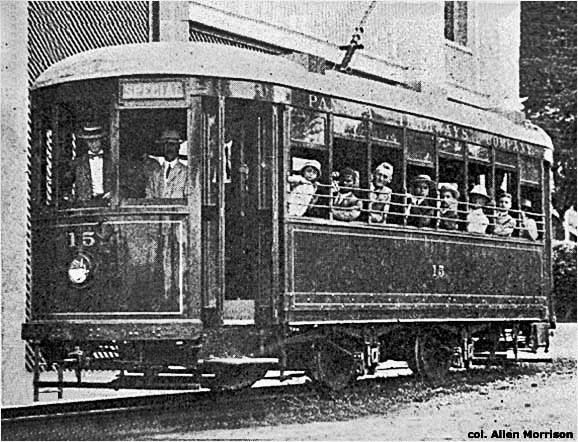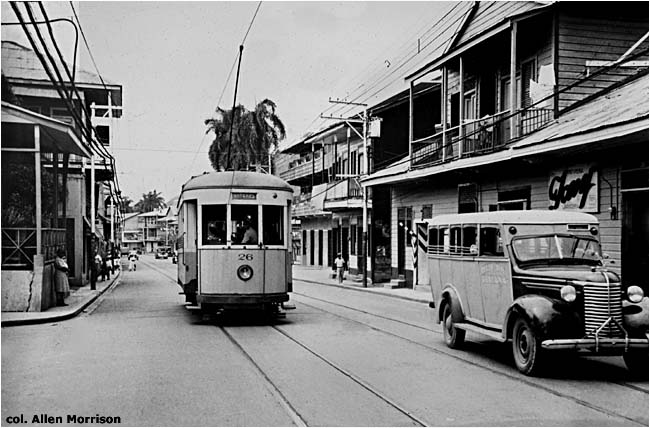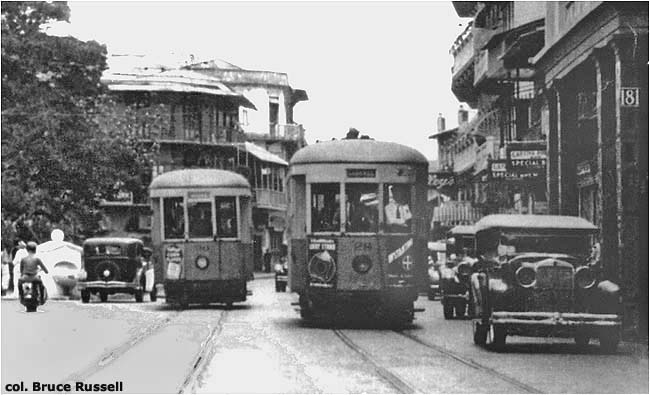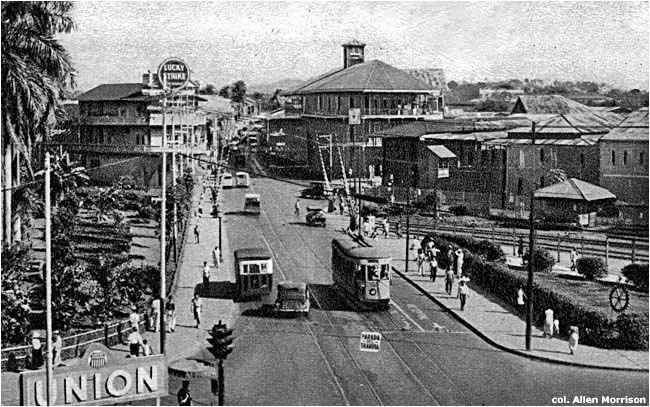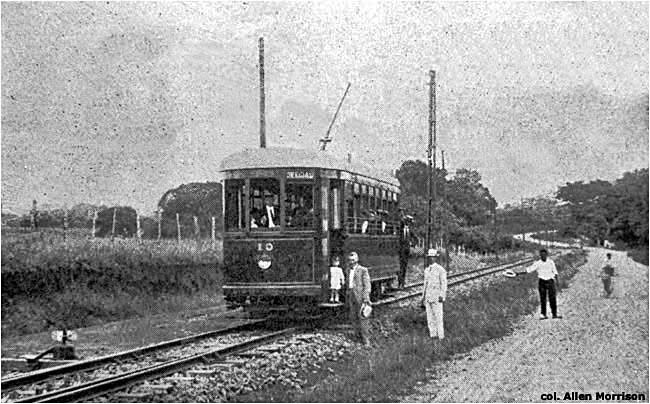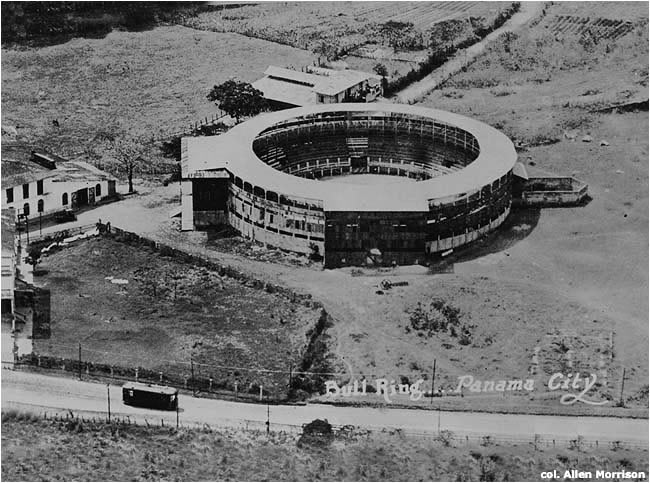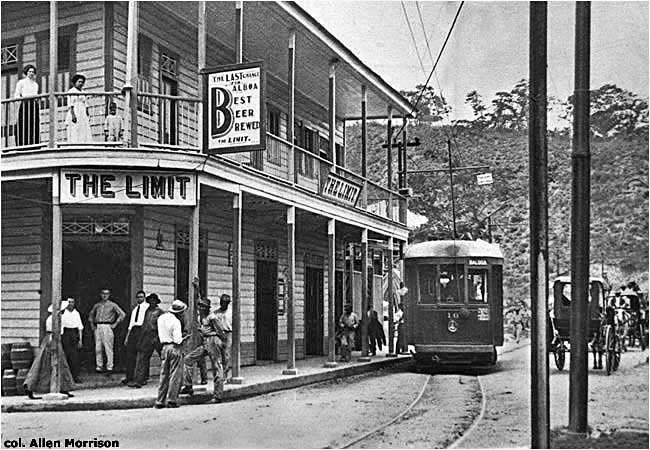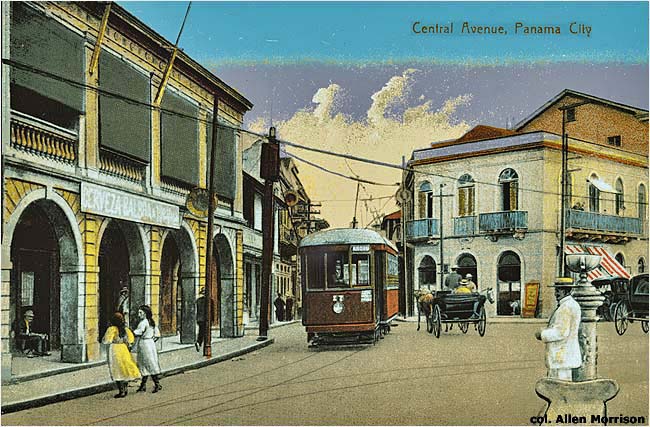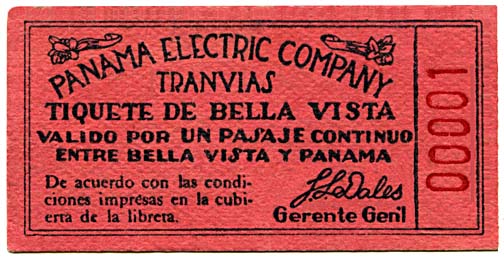The Tramways of
PANAMA CITY
COLOMBIA • PANAMA
BY
Allen Morrison
Panama City had two distinct tramway eras, which corresponded roughly to the two periods of construction of the Panama Canal [see area map]. The English built the city's first tramway in the 1890s, when Panama was still a department in Colombia and as the French were abandoning their efforts to construct the canal. After Panama became an independent state in 1903, the United States built a new tramway and a new canal. The U.S. created and occupied the Canal Zone, an area that extended 5 miles on either side of the canal and which was served by two tramway lines. The Panama City tramway was a very international affair. North Americans had built the Panama Railroad across the isthmus many years before. A train carried passengers from Colón to Gatún in 1851 [see area map] and the line reached Panama City in 1855. This was the first railway in Central America, one of the first railways in Latin America, and the first transcontinental (or interoceanic) railway in the world. Length was 48 miles. Track gauge was 60 inches. ––––––––––––––– On 16 May 1889 the Ministry of Public Works in Bogotá granted permission to a group of Colombians to build a street railway in Panama City. Financial problems arose and the franchise was finally transferred to an English group, which founded United Electric Tramways Co. in London on 22 October 1892. Siemens Brothers, an English affiliate of Siemens & Halske of Germany, built a power plant and laid track along Av. Central in Panama City [see city map]. Six trams, two closed and four open, inaugurated one of Latin America's first electric tramway systems on 1 October 1893 [see chronology]. The following two photographs were taken that year [col. AM]:
Track gauge and the origin of the trams is unknown – although the closed car is a standard U.S. type. The extraordinary thing about the vehicles is their use of side-mounted triangular power collectors – a design and arrangement not seen anywhere else in the world, before or since. Siemens had not yet perfected its familiar roof-mounted bows. Neither picture, oddly, shows overhead wire [col. AM ]:
The following report, published in the Directorio General de la Ciudad de Panamá in 1898 [see BIBLIOGRAPHY], describes the tramway company's installation, rolling stock, system length and ridership from inauguration through 1896:
Unfortunately, the tramway did not operate very long. The failure of the French to complete the canal depressed the local economy and "the War of 1000 Days" that ravaged the city from 1899 to 1902 destroyed everything else. The last tram ran sometime during that period. The exact date of closure could not be found. Panama seceded from Colombia in 1903 and the United States began construction of a new canal in 1904. On 29 October 1906 the new Panamanian government issued a concession for the construction of a new street railway in its capital, which would be larger than the first and extend into the U.S. territory of the Canal Zone. Like the first tramway contract in 1889, the new one floundered and was finally awarded to an officer of United Fruit Co., who registered Panama Tramways Co. in New Jersey on 9 November 1911. The new company hired R. W. Hebard Co. of New York as engineers and began construction in 1912. The postcard below shows Av. Central at Plaza Santa Ana [see map]. The building on the left is the same shown on the right side of the second picture above [col. AM]:
Panama Tramways Co. ordered fifteen 4-wheel closed cars, with controls and doors arranged for Panama's left-hand traffic, from Federal Storage Battery Co. in Silver Lake, New Jersey. Despite the builder's name, these were conventional electric trams with General Electric motors and trolley poles. PT also acquired seven similar vehicles from J. G. Brill in Philadelphia, as illustrated in Brill Magazine [see BIBLIOGRAPHY]:
Pictures of trams in Panama City show fleet numbers ranging from 10 to 31, so presumably the fifteen Federal cars were numbered 10-24 and the seven Brills 25-31. The numerals 1-9 were perhaps used by work cars inherited from the earlier tramway system. Here is the interior of the Brill car shown above [Brill Magazine: see BIBLIOGRAPHY]:
If the previous assumption is correct, number 25 was built in Philadelphia [col. AM]:
The new electric tramway system, which used a track gauge of 42 in, opened on 1 August 1913. The new canal opened in August 1914 (in the same month that the Great War broke out in Europe). This postcard shows the carbarn on Av. Norte. Note U.S. flag above – even though the carbarn was in Panama [see map] [col. AM]:
The celebration on Plaza Santa Ana. The tram is turning west onto Calle C in the direction of BALBOA [see map] [Electric Traction: see BIBLIOGRAPHY]:
Judging from the women's clothing, the following photograph was taken about 1918. Street location uncertain [col. AM]:
A postcard view of Plaza Santa Ana. Number 24 is headed down Av. Central toward PALACIO [see map] [col. AM]:
The postcard below shows Plaza Santa Ana about 25 years later, around 1940 [see map]. The tram is number 11. A view of the same spot 21 years earlier is shown in the second picture above [col. AM]:
A trolley excursion in 1913 [Electric Tractionsee BIBLIOGRAPHY]:
Even though the lettering Panama Tramways continued on the cars for several years, the company was reorganized in 1914 as Panama Electric Co., which was acquired by the U.S. conglomerate Electric Bond & Share ("Ebasco") in 1917. The company was American, but left-hand operation, English-style, continued on Panama streets. Car 26, signed SABANAS, is going away from the camera. The chiva (jitney bus) has doors only on its left side [col. AM]:
Another view of left-hand operation on Av. Central [see map]. The motorman is clearly visible in tram 28 coming forward [col. Bruce Russell]:
This postcard shows Av. Central where the tramway crosses the Panama Railroad. View is north. The tram is traveling south. The railroad station is out of sight on the right [see map]. Note "PARADA DE TRANVÍA" sign hanging over the street. Before the grade crossing was built about 1920, trams going to BELLA VISTA or SABANAS followed a circuitous route via Av. Norte [see map] [col. AM]:
An early view of the SABANAS suburban line [see map] [col. AM]:
The plaza de toros near SABANAS [postcard, col. AM]:
This postcard shows a popular refuge for U.S. personnel in the Canal Zone. Location is the eastern end of Balboa Road, where the tramway crossed the border into Panama (today called Av. de Los Mártires) [see map] [col. AM]:
A colorized view of Plaza Santa Ana [see map]. Tram 17, signed ANCON, is in the same spot as tram 24 shown in another postcard on this page [col. AM]:
Undated ticket for the BELLA VISTA line [see map] [col. AM]:
The 1924 edition of the McGraw Electric Railway Directory, published in New York, reported "22 motor passenger cars, 2 trail freight cars and 2 motor service cars" operating on 10.6 miles of 42 inch gauge track in Panama City. The 1940 edition of the Passenger Transport Journal Directory & Year Book, published in London, reported 20 trams and 11.2 miles of track. Some lines were closed and others were extended, but all suffered competition from jitneys and automobiles. Panama City's last streetcar ran on Saturday night, 31 May 1941. The vehicles on both of the city 's tramway systems drew electric power from overhead wires. As far as is known, Panama City never had passenger trams powered by animals, steam, batteries or gasoline. A battery-powered tram line was planned in 1910 in the city of Colón on the Caribbean coast at the other end of the Canal. The 1916 McGraw Directory reported that 3 km of track had been laid, but "the line was not in operation". It seems never to have operated. Traffic direction in Panama changed from left to right in 1943. The Canal Zone was dissolved when the United States and Panama agreed to joint control of the canal in 1979. Panama acquired complete control on 1 January 2000. The Panama Railroad was rebuilt as the Panama Canal Railway in 2000 and its track gauge changed to 56 1/2 inches. Plans for a light-rail (modern tramway) system in Panama City also began in 2000, as noted in the 11/2000 issue of International Railway Journal. But as of January 2008, no progress on the project has been made.
BIBLIOGRAPHY Panama Star & Herald (Panama City), 28/11/1893, p. 3. News item notes tramway operation. Directorio general de la Ciudad de Panamá y reseña histórica, geográfica & del departamento. Panamá, 30/8/1898, pp. 325-326. Valuable description of the tramway, its origin, finances, operation, etc. Part of text is reproduced on this page. "Panama City Tramways" in Canal Record (Ancon, Canal Zone), 5/3/1913. Description of the new tramway installation and of the earlier English line, which the text says quit in 1901. "Panama Electric Railway" in Light Railway and Tramway Journal (London), 6/6/1913, pp. 354-355. Brief description of both the earlier English tramway and the new American installation. Text says that the English system closed in 1898. "Colon Electric Tramway" in Canal Record (Ancon, Canal Zone), 16/7/1913, p. 394. Lengthy description of the battery-powered tramway project in Colón. "First Electric Railway System in Panama" in Electric Traction (Chicago), 8/1913, pp. 435-440. Extraordinary feature article with tramway map, six photographs, three diagrams and plan of the car house and company offices. Text denies the existence of the earlier tramway system. "Elektrische Bahnen: Die erste elektrische Straßenbahn in Panama" in Elektrische Kraftbetriebe und Bahnen (München), 4/10/1913, pp. 581-582. Short article based on the Electric Traction article above. Reproduces its map. "Colon Electric Tramway" in Electric Railway Journal (New York), 15/10/1913, p. 777. Text copied, without credit, from the Canal Record article above. One of its four paragraphs is omitted. "Steel Underframe Cars for Panama Tramways Company" in Brill Magazine (Philadelphia), 6/1914. Nice 4-page article describes PTC's second group of cars. Three photographs, two diagrams. The Electrician (London), 24/7/1914, p. 671. A news item entitled "Electric Traction" notes that work on the Colón tramway has been suspended. Reginald Lloyd, ed. Impresiones de las Repúblicas Sud-Americanas del Oeste en el Siglo Veinte. London, 1915. The chapter "Panama Tramway Company" on pp. 501-503 describes the new installation. Four photographs. Text notes 22 passenger cars and six freight cars. U.S. War Department. Army Corps of Engineers. Map of Panama City. Washington, 1923. Detailed street map shows entire tram system, except outer end of La Sabanas line. R. W. Hebard & Co. A Record of Engineering and Construction Contracts Undertaken in Central and South America, 1909-1926. New York, 1926. Five large photographs of the Panama City tramway. A. Hyatt Verrill. Panama of Today. New York, 1927. Street map of central area shows the tram lines. John E. Merriken. "The Panama Tramways" in National Railway Historical Society Bulletin, vol. 36 no. 4 (1971), pp. 8-15. Definitive tramway history of Panama City. Text, map (partial) and nine photographs. The source of much of the information on this page. Bob Karrer. "Clang! clang! clang! . . went the trolley" in Postcard Collector (Iola, Wisconsin), 4/1985, pp. 38-39 & 42-43. Colorful article with small reproductions of 15 postcards that show the line. Basic historical data from Merriken article above, whom the author credits. Louie Celerier. The Streetcars (Tranvias) of Panama. Memories of the Panama City trams. A superb blog posted in 2013 with detailed, illustrated description of the system. Highly recommended.
See Spanish-language version of this page For information on other tramways see If you have comments, criticism or suggestions, This page was placed online on Copyright © 2008-2108 Allen Morrison |
